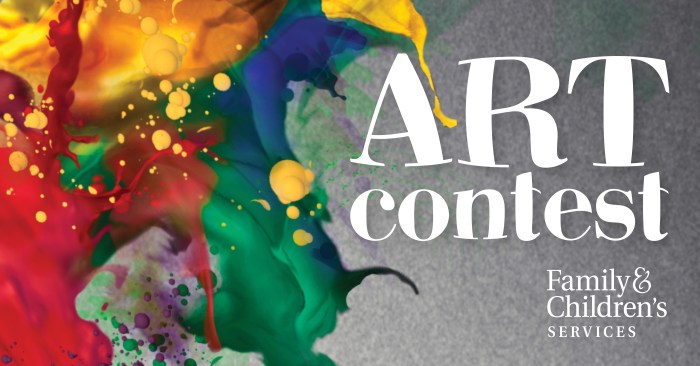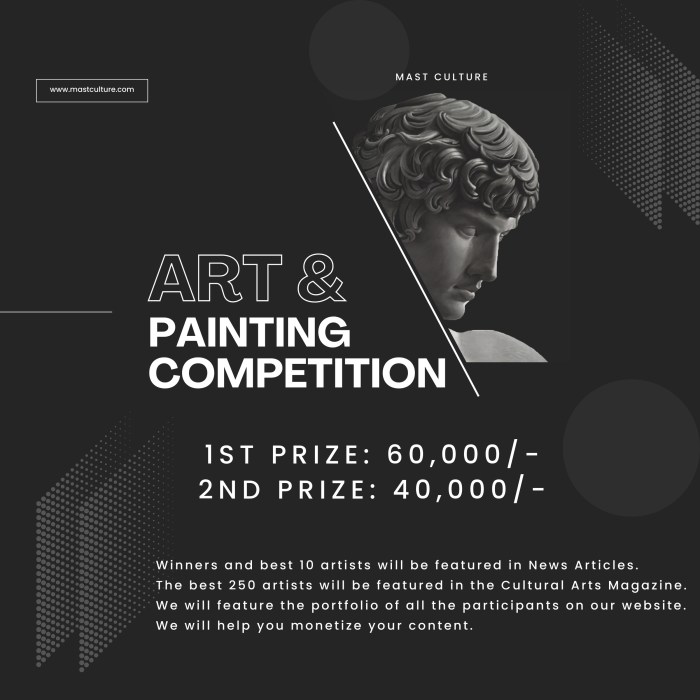Manifest art competition: The phrase itself evokes images of vibrant canvases, thought-provoking installations, and the raw energy of artistic expression vying for recognition. But what truly defines a successful manifest art competition? This exploration delves into the structure, judging criteria, and diverse styles accepted, examining the motivations of participating artists, the challenges they face, and the lasting impact these competitions have on the art world and the artists themselves.
We’ll also uncover how technology is reshaping the landscape of manifest art and its competitions.
From analyzing judging rubrics and artist profiles to exploring innovative techniques and the evolution of manifest art styles, we aim to provide a comprehensive overview of this dynamic field. We’ll dissect the role of technology in both creation and presentation, considering the influence of digital tools on accessibility and reach. Ultimately, we’ll uncover how virtual and augmented reality could revolutionize the viewing experience, pushing the boundaries of how we engage with manifest art.
Manifest Art Competitions: A Deep Dive

Manifest art competitions offer a unique platform for artists to showcase their work and engage with the broader art community. This article delves into the various aspects of these competitions, from their structure and judging criteria to the impact they have on the art world and the artists themselves. We will explore the participation of artists, the evolution of manifest art styles, and the influence of technology on this dynamic field.
Competition Overview
Manifest art competitions typically follow a structured format, inviting artists to submit their work based on specific themes or guidelines. Judging criteria often encompass originality, technical skill, artistic merit, and the effectiveness of the artist’s message. Accepted forms of manifest art are diverse, ranging from traditional mediums like painting and sculpture to more contemporary approaches such as digital installations, performance art, and mixed media pieces.
Judging Criteria and Accepted Art Forms

A typical judging rubric might assign weights to different aspects of the artwork. For instance, originality could be weighted at 30%, technical skill at 25%, artistic merit at 25%, and the effectiveness of the artist’s message at 20%. Examples of accepted manifest art include conceptual photography, video installations exploring social commentary, interactive digital sculptures responding to audience participation, and performance art pieces addressing environmental issues.
Hypothetical Judging Rubric
| Category | Weighting | Description |
|---|---|---|
| Originality | 30% | Uniqueness of concept and execution |
| Technical Skill | 25% | Mastery of chosen medium and techniques |
| Artistic Merit | 25% | Overall aesthetic quality and impact |
| Message Effectiveness | 20% | Clarity and power of the artist’s statement |
Artist Participation
Manifest art competitions attract a diverse range of artists, from emerging talents seeking recognition to established professionals looking to expand their reach. Their motivations vary, but often include the desire for exposure, critical feedback, networking opportunities, and the chance to win prizes or awards. Emerging artists may face challenges such as limited resources and less established networks, while established artists might encounter pressure to maintain their reputation and innovate.
Artist Profiles and Motivations
Participants range from self-taught individuals to those with formal art education. Motivations include gaining recognition, securing gallery representation, building a portfolio, and receiving financial rewards. The competition provides a platform for artists to share their work and connect with other artists and art enthusiasts.
Challenges Faced by Artists
Emerging artists often struggle with the costs of entry fees, materials, and travel. Established artists may face pressure to maintain their existing style while also experimenting with new techniques. Both groups might encounter challenges related to the subjective nature of artistic judgment and the competition’s overall selection process.
Artist Experience Survey Questionnaire
A survey could gather valuable insights into artist experiences. Questions might include: What motivated you to participate? What were the biggest challenges you faced? How would you rate the judging process? What was the overall impact of the competition on your career?
Manifest Art Styles and Themes
Manifest art competitions often showcase a wide spectrum of themes, from social and political commentary to explorations of personal identity and the human condition. Artists employ a variety of innovative techniques, pushing the boundaries of traditional mediums and incorporating cutting-edge technology. Styles range from minimalist abstraction to complex installations that involve multiple sensory experiences.
Common Themes and Innovative Techniques
Common themes include environmental concerns, social justice issues, technological advancements, and explorations of human emotions. Innovative techniques include the use of augmented reality to enhance viewers’ interactions with artworks, the incorporation of bio-art elements, and the exploration of data visualization as an artistic medium.
Categorized List of Manifest Art Styles
- Conceptual Art: Emphasizes ideas and concepts over traditional aesthetic concerns.
- Performance Art: Uses the artist’s body and actions as the primary medium.
- Installation Art: Creates immersive environments that engage viewers in a multi-sensory experience.
- Digital Art: Uses computer technology and digital media to create artworks.
- Mixed Media Art: Combines various materials and techniques to create a single artwork.
Evolution of Manifest Art Styles
Early manifest art (imagine a timeline) focused primarily on conceptual ideas, often expressed through minimalist forms. Over time, the integration of technology became increasingly prevalent, leading to interactive and immersive installations. The influence of social and political movements further shaped the themes and styles, resulting in a broader range of artistic expressions reflecting diverse perspectives and concerns.
Competition Impact and Legacy
Manifest art competitions significantly impact the art world by providing a platform for new talent, fostering innovation, and shaping artistic discourse. They contribute to artists’ career development by offering exposure, networking opportunities, and validation of their work. Significant competitions leave a lasting legacy by influencing future artistic trends and shaping the perception of manifest art itself.
Impact on the Art World and Artists’ Careers
Competitions can launch artists’ careers, leading to gallery representation, commissions, and critical acclaim. They also stimulate creativity and innovation within the art community by encouraging artists to explore new ideas and techniques. The prestige associated with winning awards can enhance an artist’s reputation and marketability.
Long-Term Legacy of Significant Competitions
Some competitions have established themselves as major events, shaping the course of manifest art and influencing subsequent generations of artists. Their influence extends beyond the awards themselves, impacting curatorial practices, art criticism, and public perception of manifest art. The artworks produced in these competitions often become important pieces in museum collections or private art holdings.
Hypothetical Marketing Campaign, Manifest art competition
A marketing campaign could utilize social media, targeted advertising, and collaborations with art institutions to reach a wide audience. The budget breakdown is shown below.
| Item | Cost | Quantity | Total |
|---|---|---|---|
| Advertising (Social Media & Online) | $500 | 1 | $500 |
| Website Development & Maintenance | $1000 | 1 | $1000 |
| Public Relations & Press Outreach | $750 | 1 | $750 |
| Prize Money & Awards | $2000 | 1 | $2000 |
Technological Influence

Technology plays a crucial role in both the creation and presentation of manifest art. Digital tools have expanded the accessibility and reach of manifest art competitions, enabling artists to create and share their work globally. The comparison between traditional and digital techniques reveals the unique possibilities offered by each approach.
Role of Technology in Creation and Presentation
Digital tools allow artists to experiment with new techniques, create complex installations, and easily share their work online. Virtual and augmented reality technologies are transforming the way audiences experience manifest art, offering immersive and interactive experiences beyond the limitations of traditional physical spaces.
Traditional vs. Digital Manifest Art Techniques
Traditional techniques such as painting and sculpture offer a tactile and physical experience. Digital techniques allow for greater manipulation, iteration, and accessibility, but may lack the same physicality and immediacy. Many contemporary artists blend traditional and digital techniques to create hybrid works that leverage the strengths of both approaches.
Enhancing the Viewing Experience with VR/AR
VR/AR could provide immersive, interactive experiences for viewers. Imagine viewers wearing VR headsets to explore a virtual gallery space, interacting with artworks in three dimensions. AR overlays could provide additional information about the artwork or artist, enhancing the viewer’s understanding and engagement.
Outcome Summary
Manifest art competitions aren’t merely showcases; they are vital incubators for artistic talent, shaping careers and influencing the trajectory of the art world. By understanding the nuances of judging, the diverse styles represented, and the impact of technological advancements, we can appreciate the profound role these competitions play in fostering creativity and innovation. The future of manifest art, it seems, is bright, dynamic, and deeply intertwined with the ever-evolving digital landscape.
The insights gained here provide a framework for both participants and enthusiasts to navigate and thrive within this exciting artistic arena.
Q&A: Manifest Art Competition
What types of manifest art are typically excluded from competitions?
Works that infringe on copyright or violate ethical guidelines are usually excluded. This might include pieces that are excessively violent, sexually explicit, or use unauthorized imagery.
How are prize winners typically selected in manifest art competitions?
Selection methods vary but often involve a panel of judges who score entries based on pre-defined criteria, such as originality, technical skill, and artistic merit. Sometimes, public voting is also incorporated.
What are the common challenges faced by artists in submitting their work?
Challenges include navigating submission guidelines, dealing with potential rejection, managing the costs of creating and submitting artwork, and effectively marketing their work to gain visibility.
Are there any resources available to help artists prepare for manifest art competitions?
Many art organizations and institutions offer workshops, mentorship programs, and online resources to help artists improve their skills, understand competition requirements, and build their portfolios.